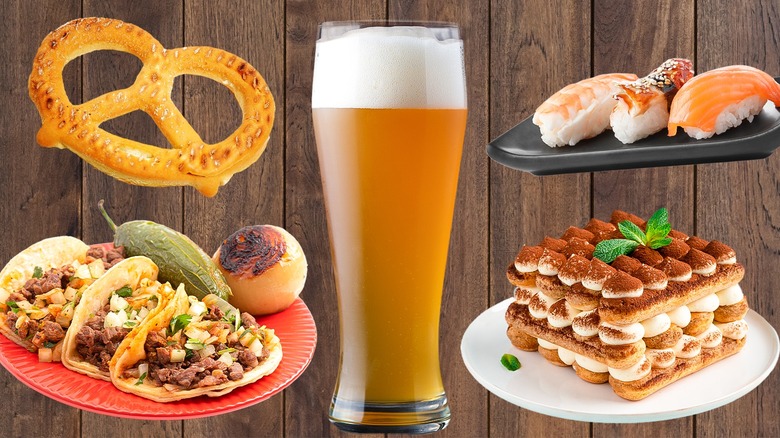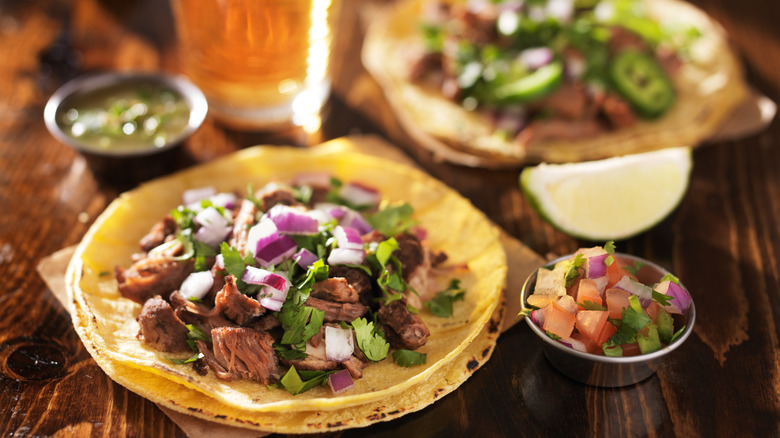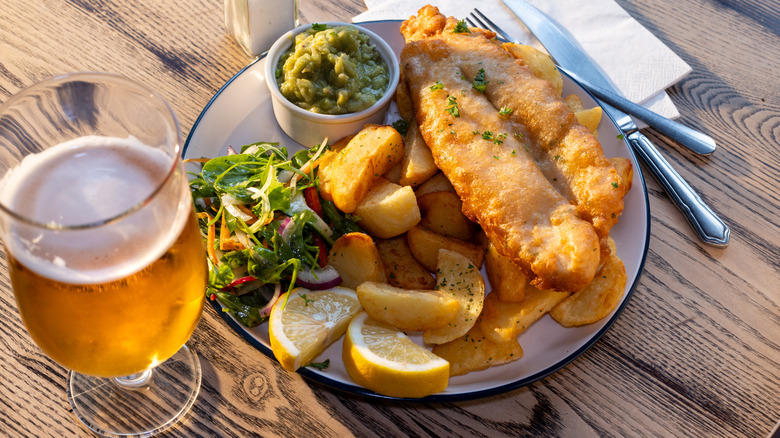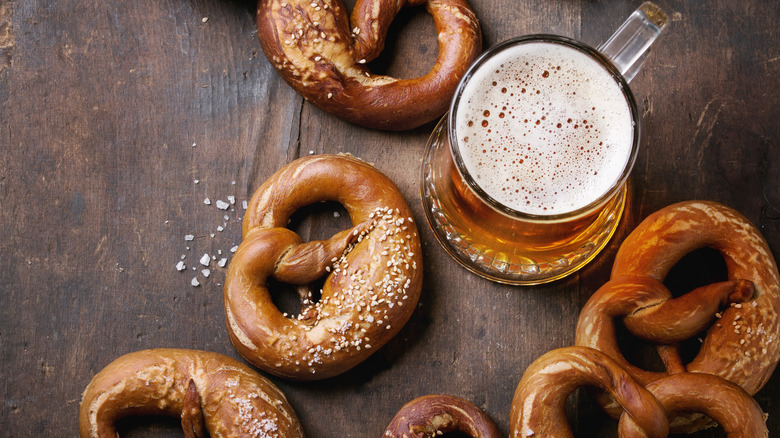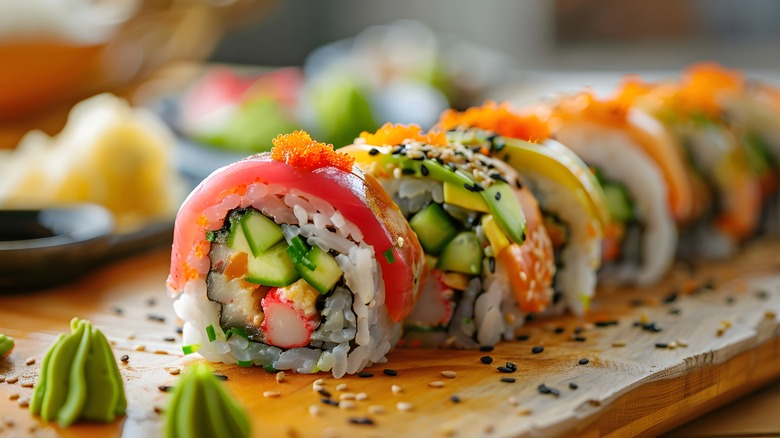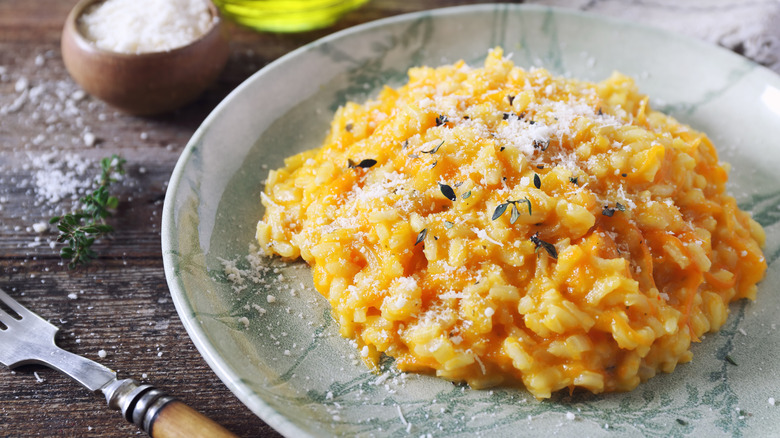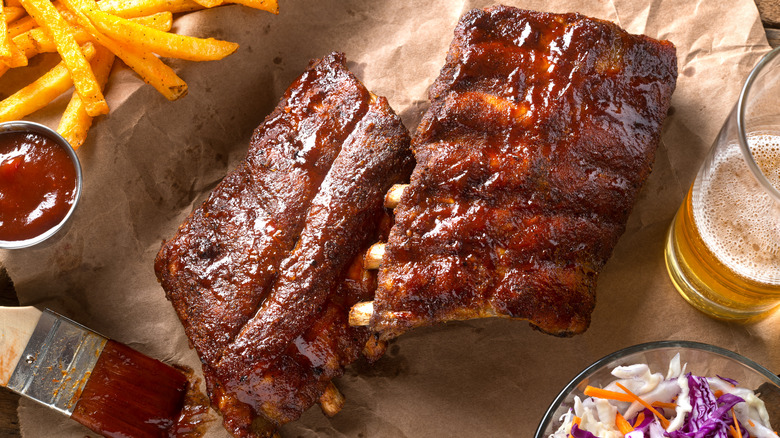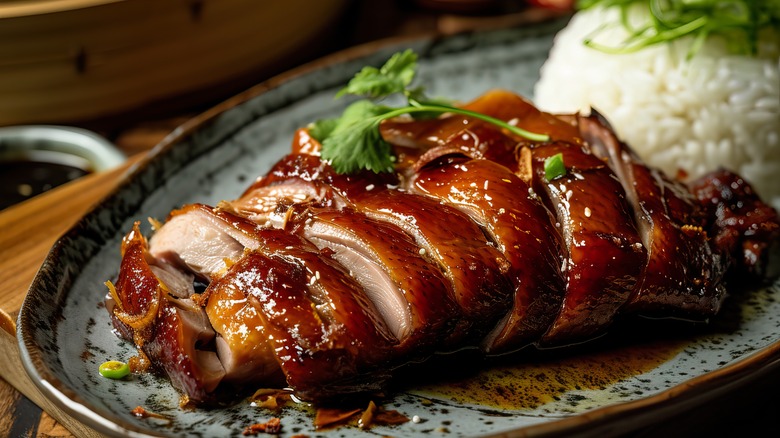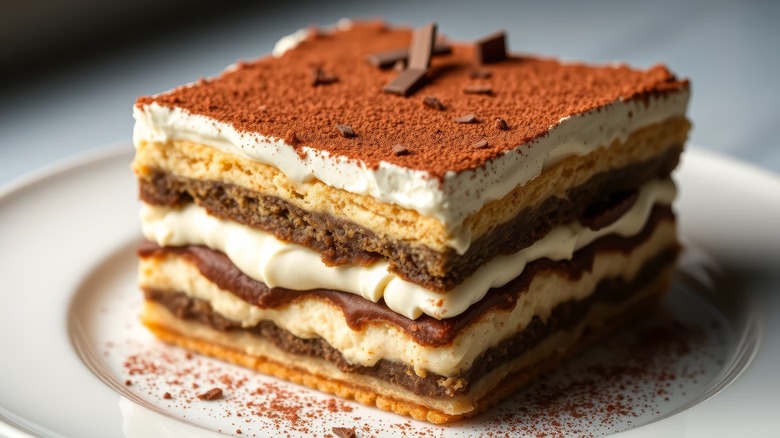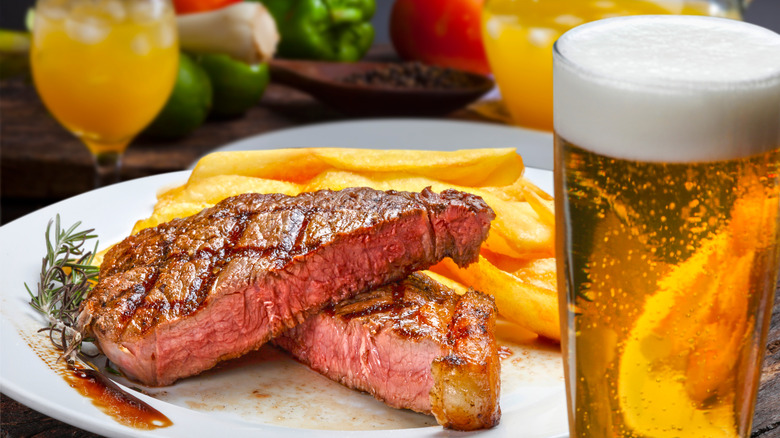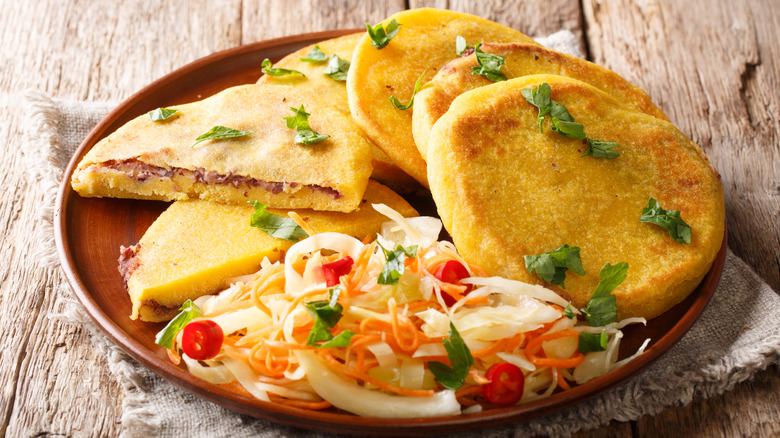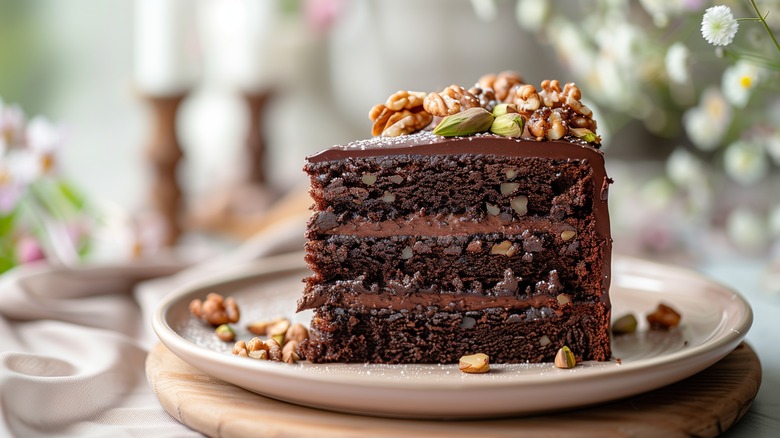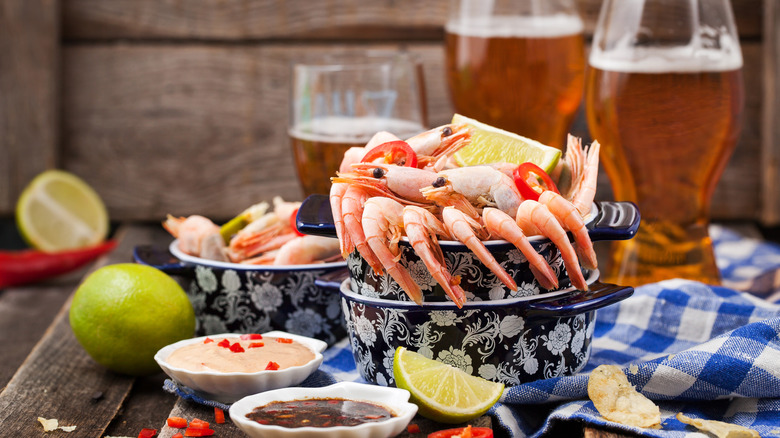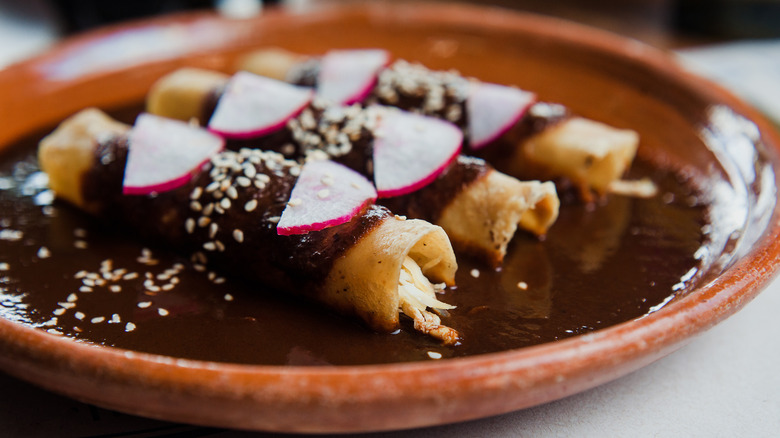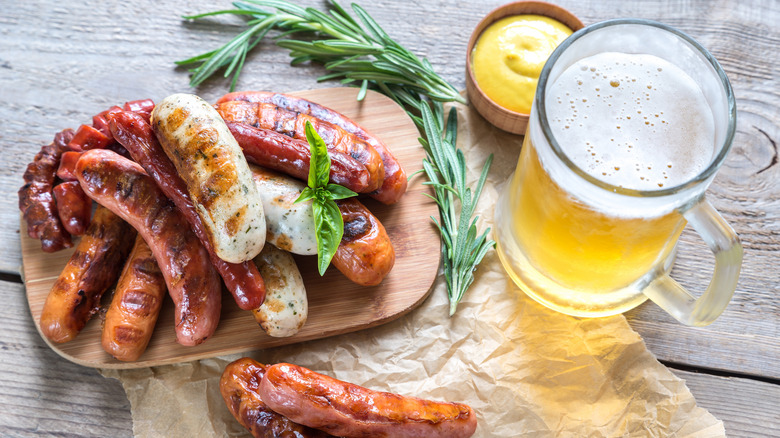14 Lager Beer And Food Pairings That You Need To Try
If lager is your preferred style of beer, you're not alone. A recent study by Future Market Insights revealed that lager is the world's most widely consumed beer, making up over half of all global beer sales. Many people love the crisp, clean character that lager gets from its bottom fermentation at cold temperatures. Adding to its appeal, lager also comes in many forms including light and refreshing pilsners, amber Vienna-style lagers, and dark dunkels. Plus, it's one of the most food-friendly beers out there.
Lager's versatility is what makes it such a great complement to so many dishes. Light lagers can cut through fatty and salty foods, while amber lagers can enhance the earthiness of meats. Dark lagers can stand up to rich sauces and even match well with desserts. With that in mind, deciding which foods to pair with your lager can be slightly overwhelming. Not to worry though because we have you covered. We asked several professional brewers and chefs about which foods go best with this popular style of beer and they gave us some stellar suggestions. According to the experts, these are the absolute best lager beer and food pairings.
Tacos
Some of the most well-known Mexican beers like Corona and Modelo are lagers, so it's not surprising that they're often paired with tacos. It's not just the shared origin that makes this food and drink combo great though. According to Chris Gonzales, director of brewery operations at Figueroa Mountain Brewing Company, "A clean, crisp lager not only pairs well with the meat of your choice to cut the fat, but it also contrasts spicy salsas with a refreshing dry finish." In addition, some Mexican beers are made with flaked corn, which matches well with corn tortillas.
While you can pair pretty much any type of taco with lager, brewer Jacob Bauch of Puesto Cervecería told us that Baja-style fish tacos and Mexican-style lagers are a match made in heaven. He cited how the beer-battered fish complements the light maltiness and slight sweetness of pale lager. Moreover, the bitter crunch of the cabbage brings out more of that sweetness and the carbonation of the beer can cut the fatty tang of lime-tinged crema. "They match each other's intensity, with neither overpowering the other, and each bite and sip inviting another," he said.
Fried foods
If you have a hankering for fried food, many experts say a crisp, light lager like a pilsner is the perfect pairing. Matthew Gallagher is the executive chef of Yard House, a chain of restaurants that offer over 100 beers on tap. He told us that he often recommends pale lagers with dishes like onion rings, fried cheese curds, and fish and chips because of the clean and simple finish the beers provide. He said, "I like light lagers with more subtle flavors or fried foods, particularly because lagers are very thirst-quenching."
Pilsners work particularly well with fried foods because they tend to be highly carbonated. The bubbles in the beer can help cut through the greasiness of battered foods and enhance the crispy sensation. In addition, pale lagers only have subtle hints of malt and hops, so they won't overpower milder dishes like tempura, chicken tenders, or fish and chips. If your fried food has a kick of heat to it, Gallagher recommends going with a dark lager because the sweet malt flavors can balance well with intense flavors like smoky chiles and spice.
Soft pretzels
Lager has a lengthy history that dates back to 13th century Germany. The name lager means "to store" in German and it comes from the fact that Bavarian monks would store the beer in cold caves as it fermented. With that in mind, it makes sense that lager tastes great with traditional German foods. Chef Dennis Littley of Ask Chef Dennis highly recommends pairing lager with soft pretzels and mustard. His go-to beer for pretzels is a German-style helles lager.
Helles means "pale" or "bright" in German and that's exactly what you get in beers with this name. But don't let the pale golden color fool you. German helles lagers are typically more malty and full-bodied than pale lagers like pilsners. The malt gives the beer a subtle sweetness and the hops add just a touch of bitterness, which works well with the flavor notes in soft pretzels. Littley explained, "The slightly sweet malt of the helles balances the saltiness of the pretzel and the tang of the mustard. These combinations work because the lager enhances without overwhelming, creating harmony between the dish and the beer."
Sushi
Sake is probably the first thing that comes to mind when many people think of an alcoholic beverage that pairs nicely with sushi. However, Dennis Littley says that lager can also work surprisingly well. He said, "The beer's gentle bitterness balances the richness of the fish, while the carbonation cleanses your palate between bites." In addition, the light flavors of lager allow the clean flavors of the fish to shine through and can enhance the umami flavors you get from the seaweed and soy sauce.
There are a few different lagers you can try with sushi. The most obvious choices are pale Japanese lagers like Asahi and Sapporo. Both are light, crisp, and have a decent amount of carbonation. A bubbly pilsner would also work well to cut through fattier cuts of fish and rolls that contain avocado or mayo. Littley also recommends Vienna lager, which is typically amber in color and contains roasted malt that gives the beer slightly toasted and sweet flavors. Those characteristics can work well with rich ingredients like barbecue eel. They can also balance the heat you get from spicy rolls and wasabi.
Risotto
Rich and creamy dishes like risotto can also benefit from a sip of lager between bites. Skip Schwartz, head brewer at WeldWerks Brewing Company, told us that one strategy he uses for pairing beer with food is to add contrast and balance by combining opposing flavors. For example, you can use a crisp beer-like lager to cut through creamy dishes. However, intensity matching is also important to prevent one element from overpowering the other. He said, "Lighter dishes should be paired with lighter beers, while robust foods can stand up to stronger-flavored beers."
Given that risottos are typically rich and packed with umami flavors from ingredients like Parmesan cheese or earthy mushrooms, you may want to go with a more full-bodied lager. Bohemian pilsners are a great choice because they have a maltiness that pairs well with creamy dishes. Dennis Littley also recommends dunkel, which is a dark lager made with malt and roasted at low temperatures. This gives the beer subtle bread-like notes and a full mouthfeel. Littley said, "The smooth body of a dunkel enhances creamy or silky dishes like risottos or creamy mushroom sauces."
American barbecue
When we asked executive chef Kristopher Ludwig of Wolf's Ridge Brewing if any regional foods pair exceptionally well with lager, American barbecue was at the top of his list. He said, "This style of beer was made for barbecue. The maltiness and roast grain undertones — absolutely the perfect pair." One of Ludwig's top lager choices for barbecued meats is a bold rauchbier. This German-style lager is made with malt that's roasted over open flames, giving it a smoky flavor that works beautifully with grilled and smoked meats.
Ludwig recommends not only sipping on a lager along with your barbecue, but also incorporating it into your dishes. For example, you can create a barbecue sauce infused with rauchbier to slather on smoked pork shoulder. Shred the pork, drizzle some of that smoky sauce on top, and you have an ultra-flavorful upgrade for your pulled pork sandwich. He also suggested marinating chicken in a Vienna lager, grilling it, then brushing or mopping the chicken with a Vienna lager barbecue sauce inspired by a Carolina barbecue sauce.
Peking duck
American barbecue isn't the only style of flame-kissed meat that washes down well with lager. Skip Schwartz told us that Peking duck is another classic dish that pairs beautifully with this type of beer. Peking duck is an iconic Chinese dish that dates back to the 1400s. The traditional method for making the duck involves pumping air under the duck's skin, then slathering it in a sweet and spicy syrup and hanging it in an oven where it's roasted until the skin is crispy and the meat is tender. The duck is typically served with thin pancakes, hoisin sauce, cucumber sticks, and scallions.
Tsingtao is a Chinese pale lager that's a great match for Peking duck. Made with mineral water from Laoshan Mountain, the beer has a light, clean taste and is effervescent enough to balance out the fattiness of the meat. Plus, the bitter hops on the finish can counter the sweetness of the hoisin sauce. Schwartz also recommends a nice amber lager. He said, "The malty sweetness and caramel notes of an amber lager complement the rich, savory flavors of Peking duck, while its moderate carbonation helps cleanse the palate between bites."
Tiramisu
Lager may not be the first thing you grab when you want an after-dinner drink to go with a sweet and creamy dessert like tiramisu. After all, there are so many rich and creamy dessert beers on the market like porters and stout beers that can complement the sweet mascarpone, coffee-soaked ladyfingers, cocoa, and hint of liqueur. However, Skip Schwartz says that you shouldn't knock a lager and tiramisu pairing until you try it. He told us that the Italian dessert pairs exceptionally well with a doppelbock-style lager.
Bock beers are dark German lagers that go heavy on the malt and have toasted notes. Doppel means "double" in German, so a doppelbock beer is a stronger version of a traditional bock beer. You can expect intense nutty, chocolatey flavors and a full mouthfeel. Schwartz said, "The rich, malty sweetness of a doppelbock complements the creamy mascarpone in the tiramisu. The beer's notes of caramel, toffee, and dark fruit mirror the dessert's coffee and chocolate undertones." In terms of intensity matching, Schwartz said the two are a perfect fit with neither overtaking the other.
Steak
Red wine is a classic pairing for steak, but many of the experts we spoke to told us lager can be a refreshing alternative. Lager's crisp carbonation can prevent the meal from feeling too heavy and complement the deep, savory flavors of the meat. However, the cut of steak and cooking method can influence which style of lager will work best. For example, Ben Chambers, director of operations at BrewDog, said, "A cut with low fat content such as filet mignon actually does better with the lighter notes of a lager to help bring out the delicate flavors the filet has been seasoned with."
If you're going for fattier cuts of steak like a ribeye or strip steak, you may want to opt for a pilsner or another pale lager to cut through the richness of the meat. Jennifer Glanville, the Samuel Adams brewer and director of partnerships at The Boston Beer Company, prefers an amber lager. She said, "The upfront malt character complements the caramelized flavors of grilled or broiled steak, enhancing its natural richness, while the lager's subtle hoppy spice cuts through the meat's richness, providing balance."
Pupusas
Being part Salvadoran, Chris Gonzales grew up eating pupusas, and he told us they're particularly tasty when paired with lager. Pupusas are the national dish of El Salvador and they consist of masa dough (corn flour and water) stuffed with ingredients like cheese, beans, and meat. The stuffed and flattened dough is griddled until the outside is golden. Pupusas are often served with curtido (a fermented cabbage slaw) and salsa roja, which adds tangy and savory elements.
Amber lagers are a great choice for pupusas because the roasted malt flavor and slight sweetness can play beautifully off richer ingredients like melted cheese and pork. You might want to try a Vienna lager or a German-style bock. Gonzales said, "On the flip side, you could have a pupusa with spicy ingredients like jalapeños and accentuate the bite with a firmly bitter pilsner." If you want an authentic Salvadoran pairing, try to track down some Pilsener brand beer. It's one of the most popular beers in El Salvador and makes for a great match for pupusas thanks to its crisp carbonation and smooth, dry finish.
Chocolate
If you're looking for a unique food and lager pairing, Jennifer Glanville is a huge proponent of chocolate. She recommends pairing chocolate desserts with an amber lager or a malt-forward, hoppy lager. She said, "The rich, malty flavors and subtle bitterness beautifully complement the complexity of chocolate." According to Glanville, the citrus notes in the hops and chocolate can add another surprising layer of harmony. She also told us that she's a big fan of beer floats made with malty lagers and chocolate ice cream.
When considering food and beer pairings, Glanville likes to follow the three C's: complement, contrast, and cut. This can work in many ways with chocolate. For example, the malt sweetness in darker lagers like dunkels and doppelbocks can contrast the bitterness you get from dark chocolate and complement the cocoa flavor. Chocolate desserts that contain nuts, caramel, or coffee can get a boost from toasty, amber lagers that mimic some of those notes. For milk chocolate, you may want to go with a light lager like a pilsener to cut the richness of the chocolate with some crispness and carbonation.
Seafood
There's nothing better than an ice-cold lager on a hot summer day. And what better summertime food to pair with your beer than fresh seafood? As a New Englander and esteemed brewer, Jennifer Glanville has had ample opportunity to experiment with different lager and seafood pairings. She told Chowhound, "For me, coastal dishes naturally pair beautifully with lagers like a helles or a pilsner." Pale lagers are light enough to be refreshing without overpowering the delicate, sweetness of seafood. They can also cut through the richness of oily fish like sardines or mackerel.
If your seafood feast includes roasted or grilled fish, an amber lager can add malty notes that complement the caramelized flavors of the fish. Richer seafood dishes like buttery lobster and seafood stew pair well with darker lagers like bocks and dunkels because the slight sweetness and smooth character of the beer can add to the decadence of the dishes. Glanville also recommends lighter lagers for fried seafood dishes like crab fritters because the lighter malt notes and bright nature of the lager can contrast nicely with the heaviness of the fritters.
Mole negro
At Puesto Cervecería, brewers Jacob Bauch and Doug Hasker create a range of Mexican lagers that pair perfectly with Mexican dishes. Typical pairings include pale lagers with tacos and seafood, and amber lagers with carne asada and roasted vegetables. However, if you want something slightly different, Bauch recommends trying a Oaxacan-style mole negro with a dark Mexican-style lager or another dark, toasty lager like a dunkel or bock. He said, "There is a real melding of flavors here that complement each other on multiple levels."
Mole negro is a traditional Mexican sauce that can contain over 20 ingredients including dried chiles, toasted nuts, raisins, chocolate, and spices like nutmeg and cloves. The sauce is often served over meats like chicken or pork. Bauch explained that dark lagers have some of the same characteristics as mole negro like nuttiness, toast, chocolate, and dark fruits. He said, "The sweetness typical of these types of dark lagers is necessary to complement the blend of spices and subtle heat of dark mole." With that in mind, Bausch warned against pairing your chicken mole with a dark lager that is bitter, roasty, and dry like a schwarzbier.
Bratwurst
If you really want to toast to tradition, Ben Chambers told us, "The quintessential traditional food and lager pairing is the German festbier and märzen lagers with the kind of fare enjoyed at Oktoberfest." One food that you'll find at nearly every Oktoberfest celebration is bratwurst. This traditional German sausage often features pork and veal seasoned with spices like nutmeg, ginger, and caraway. Brats are often grilled and served with mustard and sides like potato salad. They can also be served in a bun and topped with sauerkraut.
Chambers explained that festbier and märzen lagers work especially well with fatty and salty Oktoberfest foods like bratwurst because they tend to be slightly sweet and malty with a higher ABV than many lagers. Those characteristics can bring out the sweetness in the pork while countering the fat content in the sausage and leaving a dry finish. Both also have hoppy notes that add a spicy, floral note to the spices in the bratwurst. And as Chambers said, the bratwurst, in turn, provides "a nice gut base for longevity in the marathon of [Oktoberfest] beer drinking."
